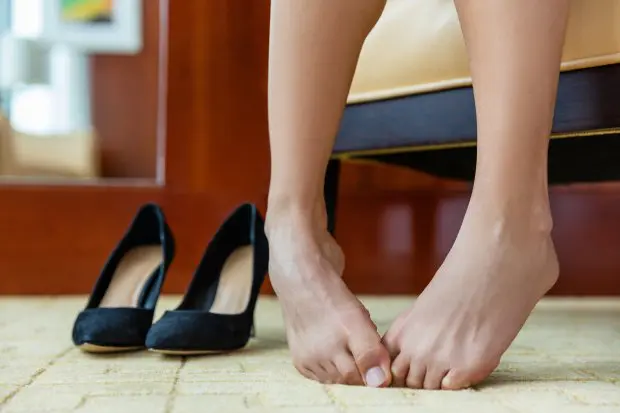
Fortunately, you can find non-invasive treatments for plantar fasciitis here at Spine Correction Center of the Rockies. Let us help you overcome your pain without resorting to risky surgery. Here are the remedies we suggest.
Buy New Shoes
Wearing high heels is a common cause of plantar fasciitis because this posture puts constant strain on your calf muscles. Consider trading in these shoes for more comfortable flats.
If you’re a runner, choose your athletic shoes wisely. They should provide ample arch support because fallen arches are another common cause of plantar fasciitis.
Stretch Your Feet
Repetitive movements, including walking and running, can tighten the muscles in your calf and Achilles tendon, putting extra strain on your plantar fascia. To help prevent this, stretch your feet and calves every morning before you get out of bed.
To do this, wrap a towel around one foot and hold onto the ends with both hands. Pull on the towel to make your foot and calf flex, stretching the muscles in the back of your leg and bottom of your foot. Hold for several seconds, and then release. Repeat on the other foot for balanced results.
Rest & Ice Your Feet
As you go about your day, take a break anytime your pain starts to flare up. Place a frozen water bottle or tennis ball on the floor and roll it across the bottom of your aching arches to enjoy some pain relief.
In the evenings when you’re relaxing, take this time to rest and ice your feet to help reduce painful inflammation. Wrap an ice pack in a towel to protect your skin and place the bottoms of your feet on the ice for 10 to 20 minutes. Cold soaks are another effective way to ice your feet.
Wear a Splint at Night
Many people with plantar fasciitis experience pain first thing in the morning because they sleep with their toes pointed. To prevent this, consider wearing a night splint to hold your feet in a semi-flexed position all night long and keep your calves and Achilles tendon from becoming tight.
You may need to wear a splint every night for a few weeks to a few months. Then, as your non-invasive treatments for plantar fasciitis start to take effect, you may be able to wean yourself off the splint until you no longer need to wear it at all.
Seek Non-Invasive Treatments for Plantar Fasciitis
The techniques you implement at home can be very effective for treating plantar fasciitis symptoms, but they may not be enough. To speed up your recovery, visit Spine Correction Center for professional treatments. We offer non-invasive protocols designed to correct gait problems and address poor posture that might be contributing to your pain.
One of our primary plantar fasciitis treatments is to prescribe a full-contact orthotic called Sole Support orthotic. This cushions your feet to provide the arch support that you need to walk and run comfortably. The results are very therapeutic and may be the key to healing from plantar fasciitis faster.
Schedule Your Free Plantar Fasciitis Consultation Today!
If you or someone you love is experiencing plantar fasciitis pain, please don’t hesitate to call Spine Correction Center at (970) 658-5115. We offer free consultations in our office or over the phone. Contact us today or set up your initial visit online when you’re ready. With our treatments, we can prevent foot pain from holding you back!
